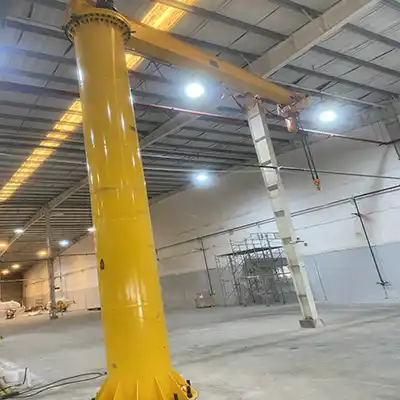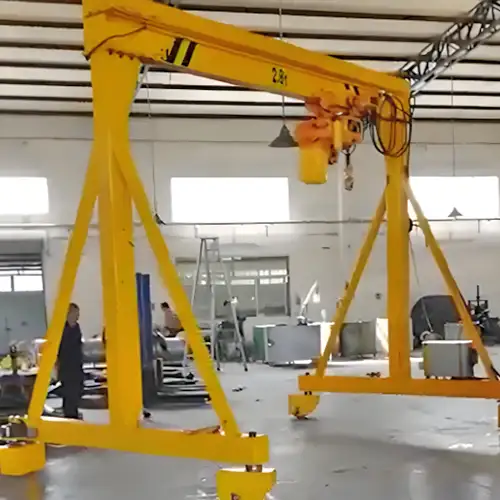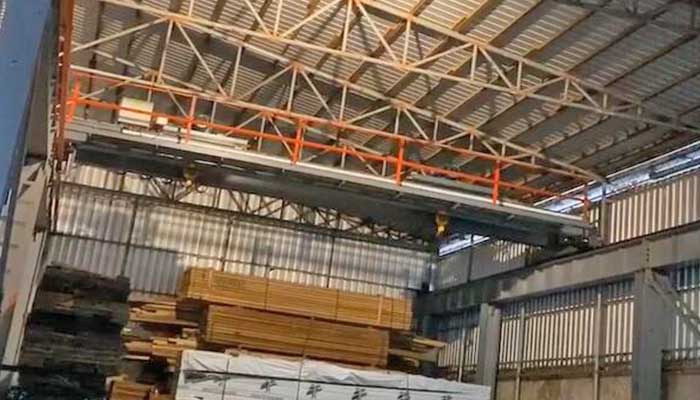
Overhead Bridge Crane vs. Floor Material Handling Equipment
Overhead material handling crane vs floor material handling equipment. Check the pros and cons of each & select right material handling equipment for you.
Material handing & material handling equipment
What exactly is material handling? Materials handling refers to the movement of raw materials from their origin to the point of use in manufacturing, their subsequent manipulation in manufacturing processes, and the transfer of finished products from factories to users or sales outlets.
What precisely is material handling equipment? Mechanical equipment designed for material movement, storage, protection, and control throughout the manufacturing process is critical for reliable distribution, consumption, and disposal processes. The efficiency and storage capacity of a warehouse, storage yard, or other material handling operation are primarily determined by the material handling equipment utilized.
In general, there are two options for moving product from point A to point B: on-floor material handling equipment and overhead bridge crane and hoists.
Floor material handling - Pros and cons
Types of material handling cranes
On-floor material handing equipment can include hand trucks, forklifts and conveyor system, etc.
Benefits of floor material handling
Trucks and forklifts have some advantages, such as being less expensive to purchase and maintain. Conveyors can be expensive and difficult to install, but they are effective for high-volume, continuous material movement.
Short-comings of floor material handling cranes
However, as the name implies, on-floor material handling equipment requires floor space.
- There are also some potential safety hazards:
- Trucks may collide with people, structures, or equipment.
When used incorrectly, forklifts can overturn, and conveyors operate at worker level, which can result in people or items becoming entangled in the machinery.
Overhead material handling equipment -Overhead bridge crane, hoists and monorails
Types of overhead handling cranes
Overhead bridge cranes, hoists, and monorails are the three types of overhead material hanlding equipment. All provide distinct advantages for various operational requirements.
Jib cranes, in particular, can rotate 360 degrees around a central space.
Bridge cranes and gantry cranes have three axles, one vertical and two perpendicular, making them ideal for working in confined spaces.
Overhead hoist
Overhead Hoists, on the other hand, are easy to adapt to larger lifting capacities and are portable to different locations. They can be used indoors or outdoors, which is why they are used in construction and warehousing environments. Because they are designed to lift and move suspended, unguided loads, they are simple devices that can be used in a variety of applications. Hoists are made of wire, rope, or chains, and they can be operated manually, electrically, or pneumatically.
Overhead monorails
Monorails are installed directly onto a facility's roof and operate on tracks, either on a single route or interconnecting a network of several tracks. Each track can have one or more carriers. They take up no floor space, unlike conveyors; however, like conveyors, they operate on a restricted path where the track has been installed, limiting the range of lifting movement.
These are used in applications where you will always be picking up and placing products at fixed points and do not need to work outside of those areas.
Overhead bridge cranes
Overhead cranes, for example, use hooks, hoists, magnets, and other devices for different material handling. They are simple and cost-effective to operate, adapting to most facility layouts and operating on any plant floor surface.A bridge crane can be as simple as a modular component designed to handle less than a hundred pounds or as complex as a component designed to handle hundreds of tons. Overhead bridge cranes can range from a simple push/pull system to a highly automated system, depending on what the customer requires for their application.
Types of Overhead Bridge Cranes for Material Handling

Single girder overhead bridge crane
Single girder overhead bridge crane specifications: Capacity:3.2 ton to 16 ton, Span: 7.5m to 28.5m,Lifting Height: 6m to 18m,Working Class:A5. Ask for single girder overhead bridge crane price.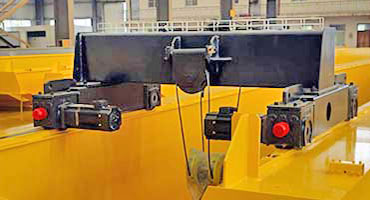
Double girder overhead bridge crane
Double girder overhead bridge crane specifications: Capacity:5 ton to 100ton,Span: 10.5m to 31.5m,Lifting Height: 6m to 18m,Working Class:A5- A7. Ask for double girder overhead bridge crane price.

Suspension bridge crane
Underslung overhead bridge crane specifications: Capacity:0.5 ton to 10 ton, Span: 3m to 31.5m, Lifting Height: 6m to 18m,Working Class:A3 to A5. Ask for underrunning crane price & suspension crane price.

Overhead KBK crane
Overhead kbk crane specifications: Capacity: 125Kg-5000Kg,Lifting Height: 2.5m-12m,Maximum Span : 3-10m,Working Class: A3. Ask for kbk crane price & kbk light crane price.
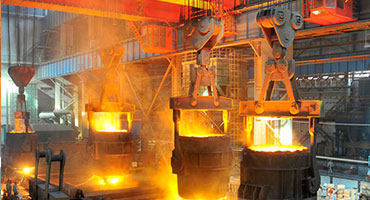
Industrial overhead crane
Customized industrial cranes for various industries such as, steel mill, oil & gas, automobile, machinery assembly, mining, general processing, etc.. Ask for industrial overhead bridge crane price.
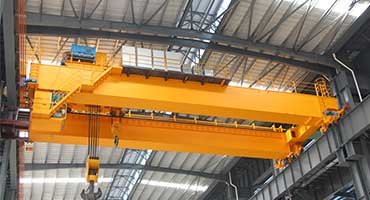
Process ovehread bridge crane
For your specific applications, the process cranes are provided to meet your specific conditions and lifting requirements to save your crane costs.. Ask for process overhead crane price.
Operation and Controls
One of the most common misconceptions about overhead bridge crane systems is that they are difficult to operate. In reality, overhead lifting solutions have simple controls and fewer electrical and mechanical components than other moving equipment, such as conveyors.
On electrified overhead crane systems, for example, a single operator can direct crane and hoist movement in three ways: crane motion, or moving the crane up and down; hoist positioning, or lateral movement; and hoisting lifting motion, or moving the hook up and down.
A worker controls the overhead bridge crane from an attached cab in basic crane operations, and another worker uses hand signals to instruct the operator on directional movements. Modern systems, on the other hand, allow one operator to use a push-button pendant system attached to the bridge crane.
Furthermore, wireless controls allow cranes to be remotely operated, adding an extra layer of safety by keeping workers well away from materials being lifted. However, when these devices first appeared on the scene a few decades ago, they were given a bad rep. Early models sent a radio signal from a remote transmitter to a receiver on the overhead material handling crane, which then converted the signal to electrical energy. Many of these devices had interference issues, causing productivity issues and general frustration.
Technological advancements have improved the transmitter and receiver processes, resulting in higher reliability. Furthermore, as these controls have become more common, their once prohibitively expensive prices have been significantly reduced.
Benefits of overhead bridge crane for material handling
Reduce injury and ensure safety
Overhead bridge crane material handling solutions, on the other hand, can improve worker safety because they do the lifting for the employee, reducing accidents and injuries caused by improper lifting. According to the most recent U.S. Bureau of Labor Statistics data on days away from work (DAFW) injuries, 118,050 manufacturing workers were injured on the job, resulting in an average of nine days off. Sprains, strains, and tears accounted for 30% of DAFW cases in manufacturing, with many of them caused by improper lifting.
No floor space is required.
The fact that overhead bridge crane equipment requires little, if any, floor space is probably its most significant advantage. Overhead bridge cranes, in particular, are ideal for facilities with narrow, crowded aisles. While freestanding bridge cranes and hoists require support structures from the floor, their footprint is much smaller than that of on-floor movers. Furthermore, these structures can be placed along the perimeters of a facility.
Furthermore, because their support structures are mounted on the building's roof, overhead bridge cranes and monorails require no floor space at all. Regardless of the type of support structure, overhead systems have a large load capacity, which is limited with some on-floor moving applications, such as hand trucks, due to the robust nature of their support.
OVERHEAD BRIGDE CRANES
PRO: REACH HIGHER HEIGHTS
Forklifts can only stack products as high as the mast will allow, so products may need to be stored across a large area on a warehouse floor or yard. Overhead cranes provide greater hook height and thus a more efficient use of space for your company.
PRO: LONGER WORKING LIFE
Electric motors are more efficient and have a longer shelf life than gas motors or batteries. Whereas forklifts have a five to ten year life expectancy, cranes can last for over 30 years, saving you money on frequent maintenance, repair, and fuel costs.
PRO: MAKE BEST VALUE OF YOUR MONEY
Multiple forklifts, certified forklift operators, and maintenance technicians can be replaced by a single crane system with one operator, making an overhead crane more cost-effective and efficient.
PRO: EXPENSIVE ACQUISITION
Overhead cranes are more expensive to buy at first than forklifts.
PRO: MORE ROOM IS REQUIRED
Overhead cranes cannot always be installed in small, compact warehouse spaces where forklifts can easily maneuver.
FORKLIFTS
PRO: PORTABLE AND COMPACT
Today's forklift models improve safety and efficiency on the job site, building on a history of warehouse, construction, and factory workers using pulleys, rope, and impromptu maneuvering systems to lift and lower loads.
Forklifts are small machines that can operate in confined spaces. They are extremely maneuverable, allowing for greater flexibility and ease in lifting and transporting loads.
PRO: VARIABLE SIZE
Forklifts range in size from small to large, with capacities of up to 1,100 pounds. No matter how much space you have, there is likely a forklift that will fit.
CON: REQUIRES CLEARE, SPACIOUS PATHWAYS
Because forklifts are on wheels, they must travel in clear paths and require wide aisles to turn. Overhead material handling cranes are more mobile and can lift and lower loads from a distance using only a walkway.
CON: IN SOME CASES, TWO WORKERS ARE REQUIRED.
When handling a heavier load, one person usually drives the forklift while another person stabilizes the load. A crane allows one person to safely lift and transport a larger load.
CON: REGULAR REPAIRS
Forklifts use tires and hydraulics, which require periodic maintenance and repair (about every few years), which can add up. If you use battery forklifts, these batteries and charging stations can be costly.
Each of these tools has advantages depending on the load size, location, and parameters of your project. However, in most cases, an overhead crane outperforms a forklift in terms of weight-bearing capacity, hook height, efficiency, and long-term cost.
If you need any any overhead bridge cranes, hoists and monorails, please feel free to contact us.
